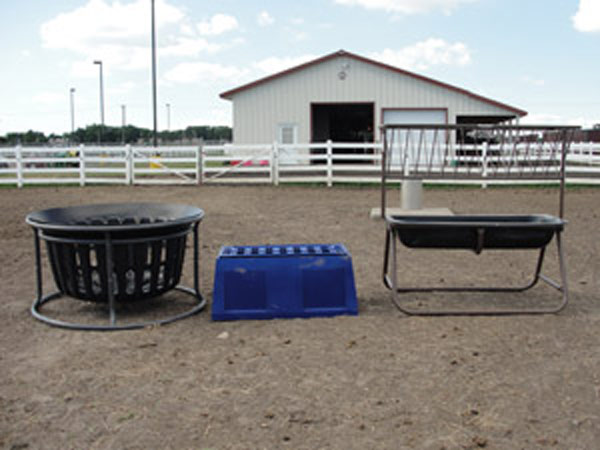
Hay is commonly fed to horses and is usually the largest and most expensive dietary component for adult horses. Hay waste can occur during both storage and feeding, and can add up to > 40%, depending on forage type, storage method, environment, and storage length. It is common knowledge that many horses are fed small square-bales in outdoor paddocks; however, no research exists to characterize hay waste of small square-bales fed in outdoor paddocks.
Objectives
The objectives of this study were to determine hay waste, herd body weight change, hay intake, and economics of small square-bale feeders when used for outdoor feeding of adult horses.
Materials and Methods
Feeder designs included a hay rack ($280; Horse Bunk Feeder and Hay Rack, Priefert Manufacturing, Mount Pleasant, TX), slat feeder ($349; The Natural Feeder, Story City, IA), and basket feeder ($372; Equine Hay Basket, Tarter Farm and Ranch Equipment, Dunnville, KY). A no-feeder control (hay fed on the ground) was also evaluated. Two feeders of each type were placed in separate, outdoor, dirt paddocks. Twelve adult horses were divided into four similar herds of three horses each and were rotated through the four paddocks, remaining in each paddock for a period of seven days. Horses were weighed before and after each rotation, and the difference was herd body weight change. Grass hay was fed at 2.5% of the herd body weight split evenly between two feedings at 8:00 am and 4:00 pm. Waste hay (hay on the ground outside of the feeder) and orts (hay remaining inside the feeder) were collected before each feeding. Percent hay waste was calculated as the amount of hay waste divided by the amount of hay fed minus orts, and hay dry matter intake was estimated as the amount of hay fed minus orts and hay waste and was expressed as a percentage of herd body weight. The number of months to repay the feeder cost (payback) was calculated using hay valued at $250/ton, and improved efficiency over the no-feeder control.
Results
Ideal weather conditions were observed during the trial period, and no injuries were observed from any of the small square-bale feeders during the trial.
Hay waste was different between small square-bale feeder designs (Table 1). Mean hay waste was 1, 3, 5 and 13% for the slat, basket, hay rack and no-feeder control, respectively. All feeders resulted in less hay waste compared with the no-feeder control, and a difference was observed between the hay rack and slat feeder. All feeders provided a physical barrier between the horses and the forage, helping to contain the hay and limit waste associated with trampling and contamination from manure and urine. Feeder design also affected payback (Table 1). The hay rack, basket, and slat feeders paid for themselves in 12, 11, and 9 months, respectively, with the slat feeder resulting in the shortest payback period compared to the other feeders.
Hay intakes differed between feeder designs, with the basket feeder and hay rack resulting in an increased hay intake compared to the slat feeder and no-feeder control (Table 1). The slat feeder presented the greatest barrier to consuming hay compared to the other feeders; therefore, the lower hay intake observed was likely a result of the higher amount of orts (remaining hay) collected from inside the feeder each day. However, given an equal amount of time between feedings (i.e., 12 hours), horses would likely have been able to consume their entire hay meal from the slat feeder. The lower hay intake observed for the no-feeder control was mostly due to a greater amount of hay waste. Herds gained small amounts of body weight when feeding from the basket feeder and hay rack, and lost small amounts of body weight when feeding from the slat feeder and no-feeder control (Table 1). Changes in herd body weight reflect hay intake for each feeder and the no-feeder control.
Table 1. Hay waste, estimated hay intake, herd body weight change, and payback of three small square-bale feeders and a no-feeder control used to feed adult horses in outdoor paddocks
Benefits to the Equine Industry
These results demonstrate that small square-bale feeder design affected hay waste, estimated hay intake, herd body weight change and payback when adult horses were fed in outdoor paddocks. This information will aid horse owners and professionals when purchasing small square-bale feeders and estimating hay needs.
Acknowledgement
This research was authored by Amanda Grev, Emily Glunk, Marcia Hathaway, William Lazarus, and Krishona Martinson, University of Minnesota. This project was supported by a grant from the American Quarter Horse Foundation.


